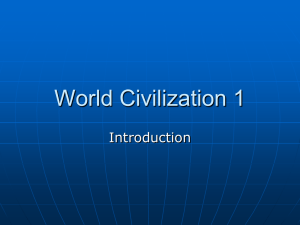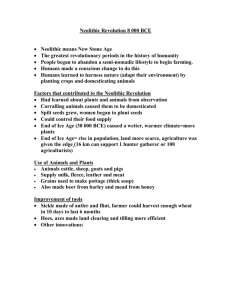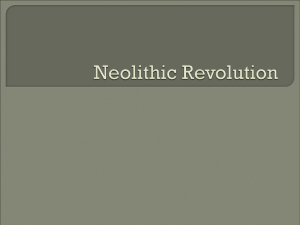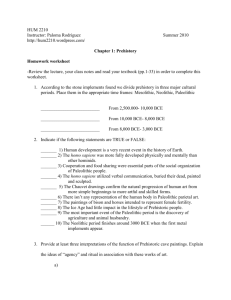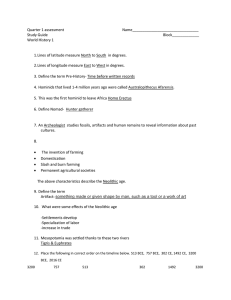Pre-AP Chapter 1 Notes: Prehistory to 2500 Section 1
advertisement
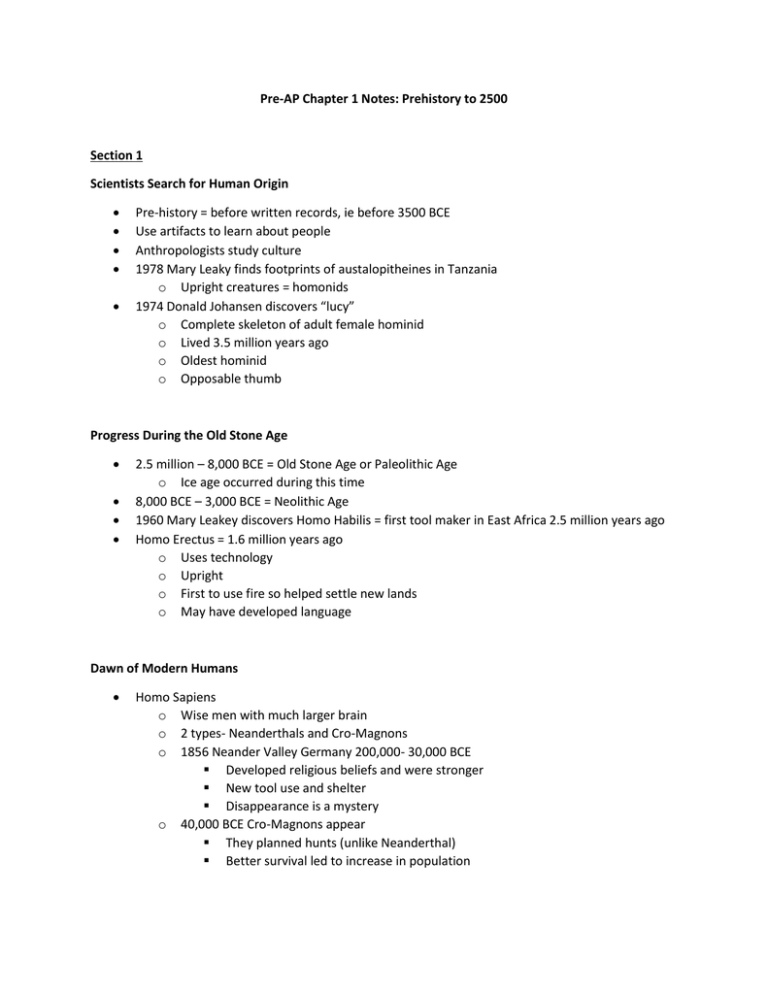
Pre-AP Chapter 1 Notes: Prehistory to 2500 Section 1 Scientists Search for Human Origin Pre-history = before written records, ie before 3500 BCE Use artifacts to learn about people Anthropologists study culture 1978 Mary Leaky finds footprints of austalopitheines in Tanzania o Upright creatures = homonids 1974 Donald Johansen discovers “lucy” o Complete skeleton of adult female hominid o Lived 3.5 million years ago o Oldest hominid o Opposable thumb Progress During the Old Stone Age 2.5 million – 8,000 BCE = Old Stone Age or Paleolithic Age o Ice age occurred during this time 8,000 BCE – 3,000 BCE = Neolithic Age 1960 Mary Leakey discovers Homo Habilis = first tool maker in East Africa 2.5 million years ago Homo Erectus = 1.6 million years ago o Uses technology o Upright o First to use fire so helped settle new lands o May have developed language Dawn of Modern Humans Homo Sapiens o Wise men with much larger brain o 2 types- Neanderthals and Cro-Magnons o 1856 Neander Valley Germany 200,000- 30,000 BCE Developed religious beliefs and were stronger New tool use and shelter Disappearance is a mystery o 40,000 BCE Cro-Magnons appear They planned hunts (unlike Neanderthal) Better survival led to increase in population Section 2: Humans Try to Control Nature Achievements in Technology and art Increased cultural change and innovation , which is different than spending most of your time trying to survive Nomads and hunter gatherers o Tool development to improve efficiency of hunting = technological revolution and includes spears, knives, harpoons Paleolithic Art o Cave paintings in France and Spain o Made from charcoal, animal blood, mud o Images of wild animals o Represented religious beliefs o Pictures are the precursor to writing as a form of communication Neolithic Revolution Causes o Change in climate led to longer growing seasons o Rise in populations meant people needed more steady food supply Early farming methods o Slash and burn farming, where ashes provided fertilizer for the crops Domestication of animals o Tamed horses, dogs, goats, and pigs o Manmade enclosures Jarmo- present day Iraq o Site of first Neolithic revolution because of good climate and animals for domestication Villages Grow and Prosper Farming develops in many places o Africa- Nile o China – Huang He o Mexico and Central America – Olmec o South America – Chavin Catal Huyuk in Turkey o Example of early agricultural village o Large crops, sheep and cattle o Obsidian used to make mirrors, jewelry and knives o Home to about 6,000 people o Wall paintings of animals and hunting scenes o Religious shrines o Drawbacks- spread of disease and looting Section 3: Civilization Villages Grow into Cities People develop technology to control natural environment producing more food and thus a larger population Economic Changes o Built elaborate irrigation systems o Food surpluses allowed for specialization of workers o Craftspeople led to traders o Wheel and sail enabled more trade Social changes o Special groups of workers led to social classes of various wealth, power, and influence o Religions became more organized with common beliefs o Religion went from beliefs centered around nature and animal spirits to gods and goddesses that controlled nature What is Civilization? Advanced Cities o Civilization from the Latin word city o City is a center of trade for a large area Specialized Workers o Food surpluses allowed for specialization- development of skills for a specific kind of work o Artisans developed- which helped trade and hence cities Complex Institutions o Soaring populations made government (a system of ruling) essential o Leaders emerged to maintain order and establish laws o Government, religion, economy o Temples built o Food and trade items distributed to the city’s residents Record Keeping o Need to document tax collection, passage of laws, storage of grain, calendar year, accounts of debts and payments o 3000 BCE Cuneiform in Sumer done by scribes- professional record keepers Clay tablets Began writing about wars, natural disasters, kings Advanced Technology o Ox-drawn plows o Irrigation systems o Potter’s wheel o Bronze by melting copper and tin- used later for spear heads Civilization in Ur 3,000 BCE Ur in Sumer emerged Supported about 30,000 people Agricultural economy o Irrigation projects o Government support of public works Glimpse of City Life o Social classes (and houses that reflect those differences) o Artisans Ur’s Thriving Trade o Barter o Scribe services needed to record payments and debts Temple: Center of City Life o Ziggurat = mountain of god Religious Ritual Recorded o Burial rituals o Belief in the afterlife o Wide range of crops o Stories of love
